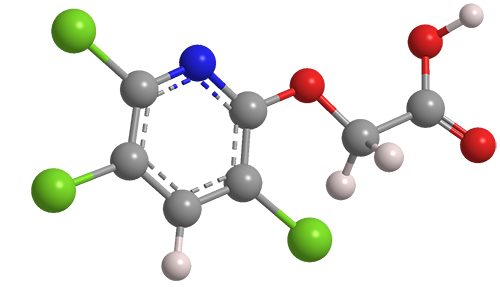What molecule am I?


Triclopyr is a trichloropyridine-based broadleaf herbicide that was developed by Dow Chemical (Midland, MI) in the 1970s. It was originally synthesized in 1958 by M. P. Cava and N. K. Bhattacharyya at Ohio State University (Columbus).
Triclopyr is a mimic of a plant growth hormone called an auxin. This type of herbicide kills the target weed by imitating the auxin indole-3-acetic acid1. When it is administered at effective doses, it causes uncontrolled, disorganized plant growth that leads to plant death.
Despite its three chlorine atoms, triclopyr is a relatively safe, nonpersistent pesticide. It was originally developed as a crop-protection product, but it and other herbicides have more recently been used to combat invasive plant species.
One example is triclopyr’s use against the Hawaiian invasion of miconia trees (Miconia calvescens) from Central and South America. Miconia grows and spreads rapidly; and its large leaves block the sunlight from native plants. To make matters worse, birds are fond of miconia fruit and spread the plant’s seeds, often in inaccessible locations.
The Big Island (Hawai‘i) is already overrun with miconia, but the trees have made only small inroads into the nearest island, Maui. Scientists James Leary at the University of Florida (Gainesville) and Adam Knox of the Maui Invasive Species Committee of the University of Hawai‘i developed and use an innovative technique to locate and eradicate the plants.
Leary, while at the University of Hawai‘i at Manoa about 15 years ago, prepared a triclopyr formulation that can be used to make paintball capsules. For the past decade, he, Knox, and their team have used helicopters to locate and “shoot” miconia with herbicidal paintballs. During that period, they have killed ≈26,000 of the invasive species.
1. CAS Reg. No. 87-51-4.
Triclopyr hazard information*
| Hazard class** | GHS code and hazard statement | |
|---|---|---|
| Acute toxicity, oral, category 4 | H302—Harmful if swallowed | |
| Acute toxicity, dermal , category 5 | H313—May be harmful in contact with skin | |
| Serious eye damage/eye irritation, category 1 | H318—Causes serious eye damage | |
| Acute toxicity, inhalation (vapors), category 3 | H331—Toxic if inhaled | |
*Compilation of multiple safety data sheets.
**Globally Harmonized System (GHS) of Classification and Labeling of Chemicals. Explanation of pictograms.
Triclopyr fast facts
| CAS Reg. No. | 55335-06-3 |
| SciFinder nomenclature | Acetic acid, 2-[(3,5,6-trichloro-2-pyridinyl)oxy]- |
| Empirical formula | C7H4Cl3NO3 |
| Molar mass | 256.47 g/mol |
| Appearance | Fluffy colorless or white crystals or solid |
| Melting point | 150.5 °C |
| Water solubility | 440 mg/L |

Learn more about this molecule from CAS, the most authoritative and comprehensive source for chemical information.
Molecule of the Week needs your suggestions!
If your favorite molecule is not in our archive, please send us a message. The molecule can be notable for its current or historical importance or for any quirky reason. Thank you!
Stay Ahead of the Chemistry Curve
Learn how ACS can help you stay ahead in the world of chemistry.

